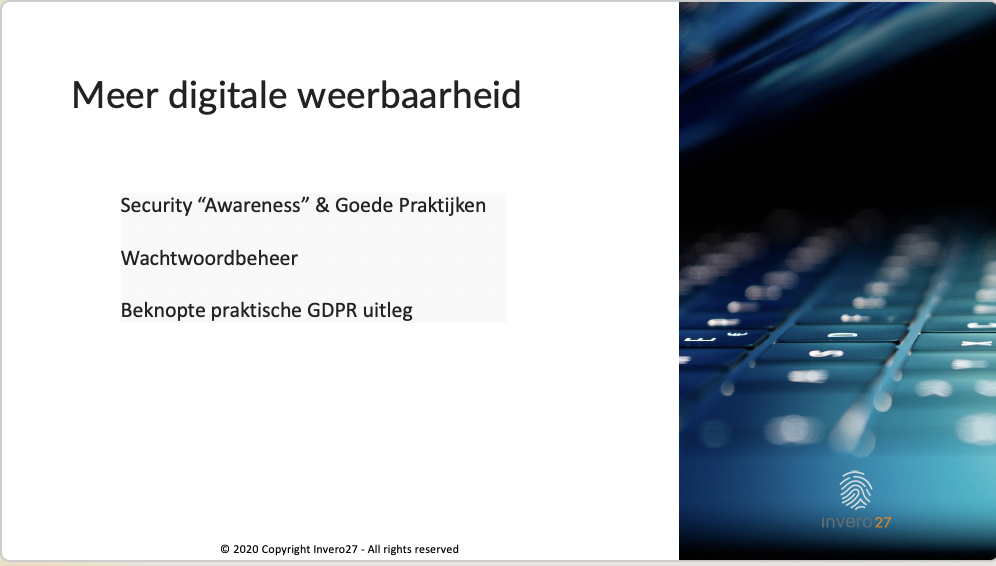
- Leraar: Dirk De Nijs

Cybersecurityaanvallen, hacking, phising en digitale lekken: bijna elke dag lees je er iets over.
Veel internetgebruikers, ondernemers en particulieren, denken dat zij hier nooit mee te maken zullen krijgen. Helaas.
Neem daarom de juiste maatregelen op het vlak van digitale veiligheid.

E-learning kan verschillende vormen aannemen. We maken hierbij een onderscheid tussen synchrone en asynchrone vormen van e-learning.
De synchrone vormen kenmerken zich door een gelijktijdig aanwezig zijn van de cursisten en/of lesgevers in een virtuele omgeving.
Wanneer van cursisten verwacht wordt dat zij zelfstandig en op eigen tempo een online lessenpakket doornemen, spreken we van asynchroon e-learning.
We schetsen de verschillende vormen van synchroon en asynchroon e-learning en geven praktische tips over hoe deze vormen effectief en doordacht kunnen worden ingezet. Het is hierbij belangrijk om een doordachte keuze te maken voor een combinatie van synchrone en asynchrone vormen.
Een grote valkuil van e-learning is dat cursisten onvoldoende gestimuleerd worden om zelf actief met de stof aan de slag te gaan en het hele gebeuren dus eerder passief zullen ervaren. We zullen dan ook een aantal bijkomende algemene tips gegeven om aan deze valkuil tegemoet te komen.
Cyber security attacks, hacking, phishing and digital leaks: you read about it almost every day.
Many internet users, entrepreneurs and individuals, think that they will never have to deal with this. Unfortunately.
Therefore, take the right measures in the field of digital security.

E-learning can take different forms. We make a distinction between synchronous and asynchronous forms of e-learning.
The synchronous forms are characterized by the simultaneous presence of the students and / or teachers in a virtual environment.
When students are expected to go through an online lesson package independently and at their own pace, we speak of asynchronous e-learning.
We outline the different forms of synchronous and asynchronous e-learning and give practical tips on how these forms can be used effectively and thoughtfully. It is important to make a well-considered choice for a combination of synchronous and asynchronous forms.
A major pitfall of e-learning is that students are insufficiently stimulated to actively work with the material themselves and are therefore more likely to experience the whole thing passively. We will therefore give a number of additional general tips to overcome this pitfall.
Attaques de cybersécurité, piratage, hameçonnage et fuites numériques: vous en lisez presque tous les jours.
De nombreux internautes, entrepreneurs et particuliers, pensent qu'ils n'auront jamais à faire face à cela. Malheureusement.
Par conséquent, prenez les bonnes mesures dans le domaine de la sécurité numérique.

L'apprentissage en ligne peut prendre différentes formes. Nous faisons une distinction entre les formes d'apprentissage en ligne synchrones et asynchrones.
Les formes synchrones se caractérisent par la présence simultanée des étudiants et / ou des enseignants dans un environnement virtuel.
Lorsqu'on attend des étudiants qu'ils suivent une trousse de cours en ligne de manière autonome et à leur propre rythme, on parle de e-learning asynchrone.
Nous décrivons les différentes formes d'apprentissage en ligne synchrone et asynchrone et donnons des conseils pratiques sur la manière dont ces formulaires peuvent être utilisés de manière efficace et réfléchie. Il est important de faire un choix judicieux pour une combinaison de formes synchrones et asynchrones.
L'un des principaux écueils de l'e-learning est que les étudiants ne sont pas suffisamment stimulés pour travailler eux-mêmes activement avec le matériel et sont donc plus susceptibles de vivre le tout de manière passive. Nous donnerons donc quelques conseils généraux supplémentaires pour surmonter cet écueil.